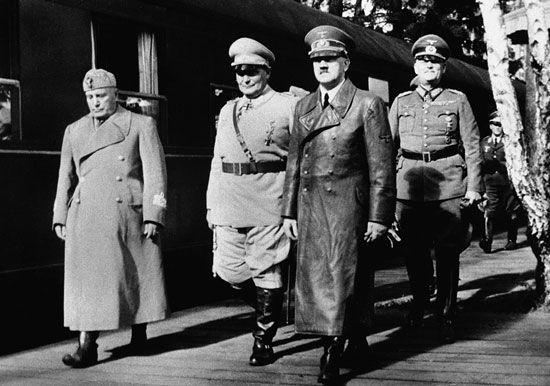Axis powers
Our editors will review what you’ve submitted and determine whether to revise the article.
- The National WWII Museum - The Axis Powers of World War II
- Khan Academy - 1940 - Axis gains momentum in World War II
- Pressbooks.ccconline.org - PPSC HIS 1120: The World: 1500-Present - Axis Powers
- Warfare History Network - Axis Powers: The Infamous Tripartite Pact
- United States Holocaust Memorial Museum - Holocaust Encyclopedia - Axis Powers in World War II
- Date:
- May 22, 1939 - September 2, 1945
- Related People:
- Adolf Hitler
- Benito Mussolini
- Joachim von Ribbentrop
Axis powers, coalition headed by Germany, Italy, and Japan that opposed the Allied powers in World War II. The alliance originated in a series of agreements between Germany and Italy, followed by the proclamation of an “axis” binding Rome and Berlin (October 25, 1936), with the two powers claiming that the world would henceforth rotate on the Rome-Berlin axis. This was followed by the German-Japanese Anti-Comintern Pact against the Soviet Union (November 25, 1936).
Hostile acts of expansionism by the three countries during the 1930s sowed the seeds of world war. Fascist Italy invaded Ethiopia on October 3, 1935. Imperial Japan, which had occupied Manchuria (Northeast China) since 1931, engaged Chinese troops near Beijing on July 7, 1937, thus launching full-scale warfare there. Nazi Germany occupied the Rhineland in 1936 and annexed Austria and the Sudetenland two years later.
On September 13, 1936, as he began to set his sights on the Soviet Union, German dictator Adolf Hitler boasted of the blind obedience that he would be able to command from the German people in a struggle against bolshevism. Hitler’s tirades against bolshevism were delivered not only in order to justify German intervention on the side of the fascist-oriented Falange in the Spanish Civil War (1936–39) but also to prepare the ground for alliance with Japan, where nationalism and militarism had been ascendant since Japan’s occupation of Manchuria. On November 25, 1936, Germany’s foreign minister, Joachim von Ribbentrop, and Japan’s ambassador in Berlin, Count Mushakoji, signed an agreement, the so-called Anti-Comintern Pact: since the Comintern, or Third International, based in Moscow, existed in order “to disintegrate and subdue existing states,” Germany and Japan undertook “to consult with one another on the necessary preventive measures and to carry these through in close collaboration.”

Germany had not enacted any sanctions against Italy during the Italo-Ethiopian War (1935–36): firmly resolved on annexing Austria to Germany, Hitler was waiting until Italy’s war was over before making his next move on the international chessboard. Then, after a bitter campaign in the Nazi press against the Austrian chancellor Kurt von Schuschnigg, German diplomat Franz von Papen, in May 1936, started negotiations with Schuschnigg for a modus vivendi. A draft agreement between Germany and Austria was submitted to Italian dictator Benito Mussolini, whose approval was obtained on June 5. An official communique published in Berlin and in Vienna on July 11 stated that the German Reich recognized Austria’s full sovereignty and that Austria undertook, “both in general and toward the German Reich,” to pursue the policy of “a German state.” A visit by Galeazzo Ciano, Mussolini’s son-in-law and minister of foreign affairs, to Hitler at Berchtesgaden on October 24 was followed by Germany’s becoming the first power to recognize Italy’s annexation of Ethiopia. On November 1, in Milan, Mussolini completed the bargain by proclaiming the Rome-Berlin Axis and by violently attacking communism.
In the last week of September 1937, when he paid a state visit to Germany, Mussolini received a spectacular welcome. Convinced that in a forthcoming war the Nazi Reich would be victorious, he formally subscribed to the German-Japanese Anti-Comintern Pact on November 6 of that year, and on December 11 he withdrew Italy from the League of Nations. Germany, Italy, and Japan now formed a triangle.
The connections among the Axis powers were strengthened by a full military and political alliance between Germany and Italy (the Pact of Steel, May 22, 1939) and by the Tripartite Pact, signed by all three powers on September 27, 1940, one year after Germany’s invasion of Poland and the beginning of World War II. During the war a number of other countries joined the Axis, induced by coercion or promises of territory or protection by the Axis powers. They included Hungary, Romania, and Slovakia (after Czechoslovakia had divided in 1939) in November 1940, Bulgaria and Yugoslavia in March 1941, and, after the wartime breakup of Yugoslavia, Croatia (June 1941). Finland, although it did not formally join the Tripartite Pact, cooperated with the Axis because of its opposition to the Soviet Union (to which Finland had been forced to cede territory in 1940) and entered the war in 1941.





















